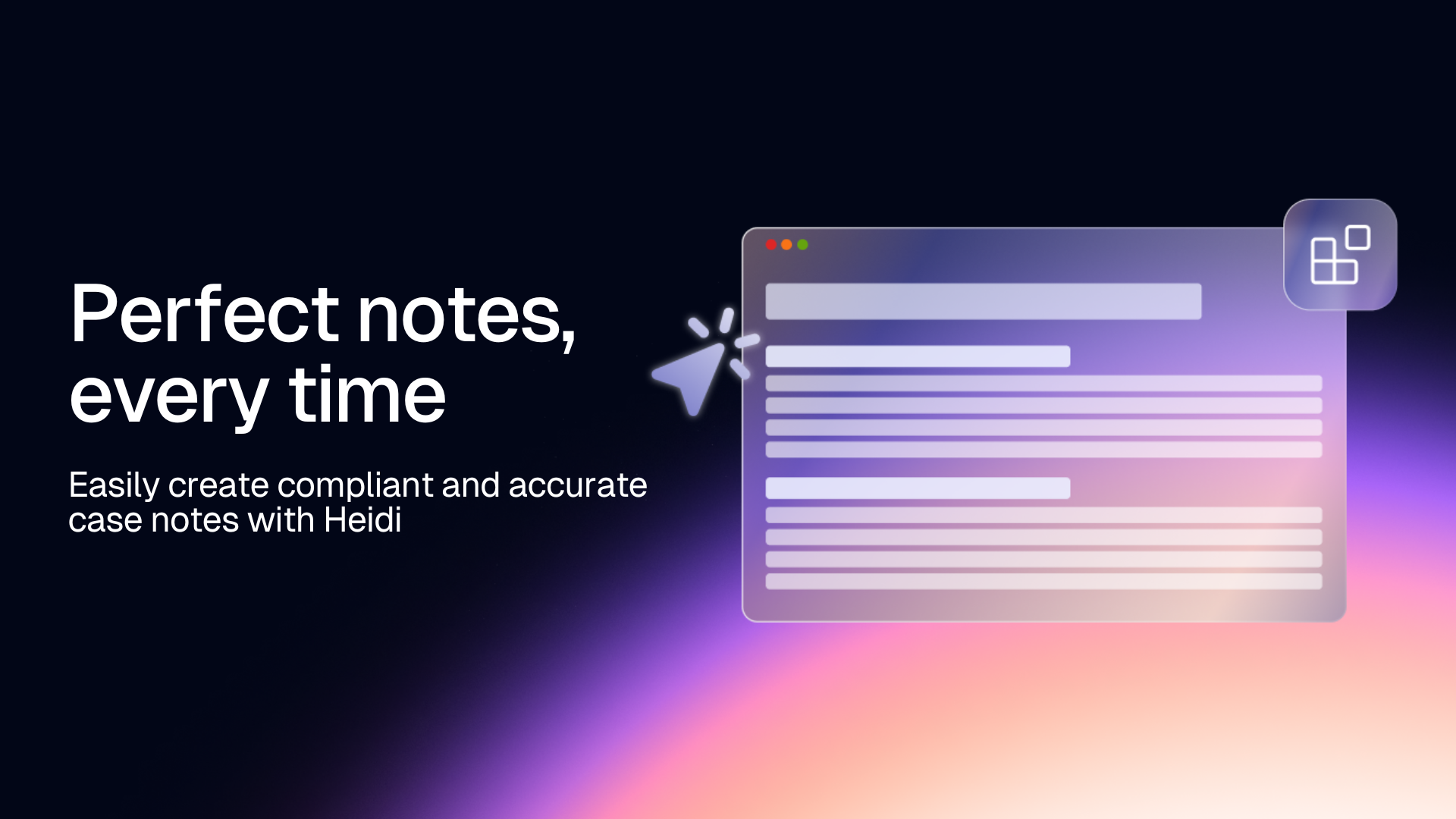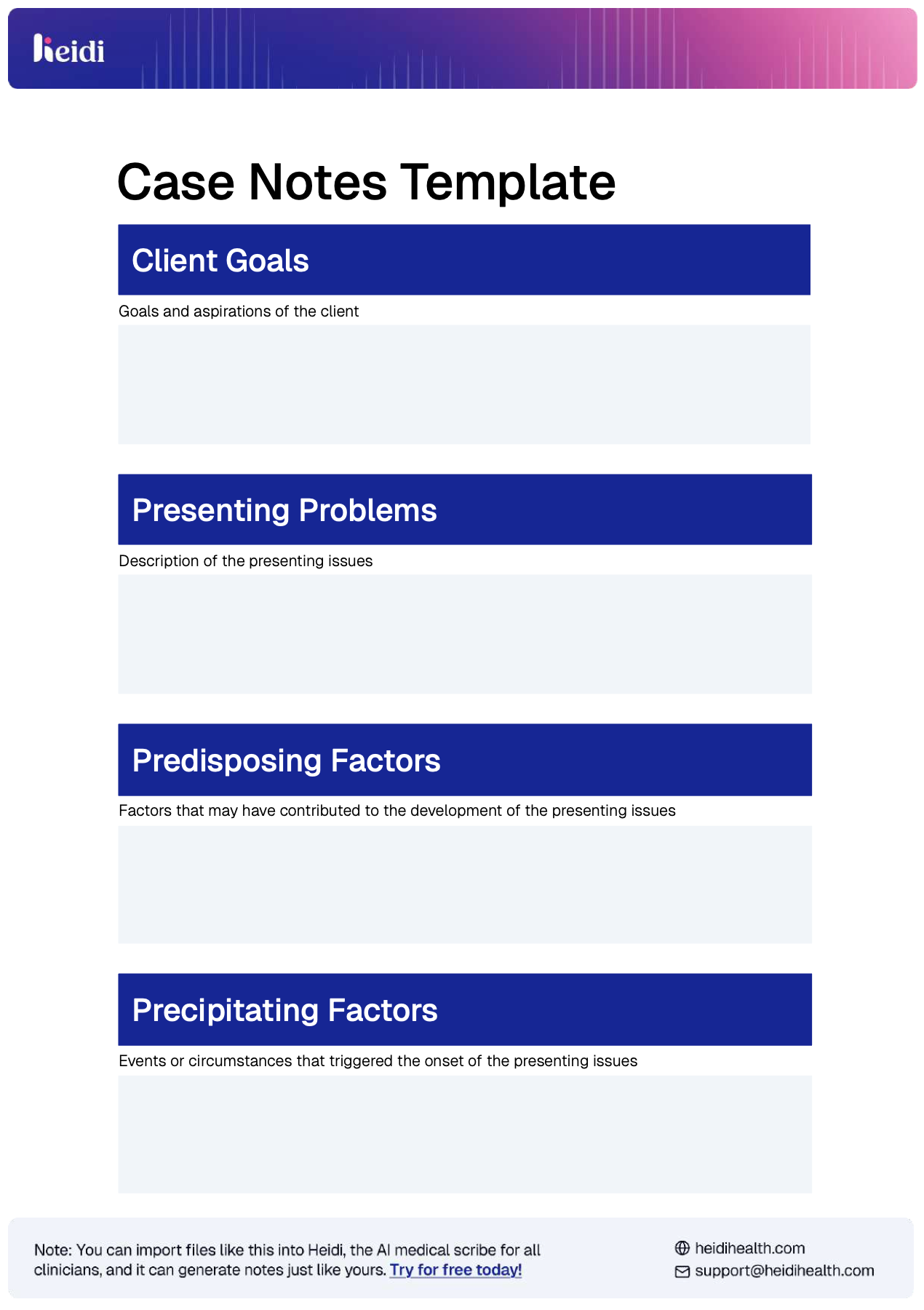Case Note Templates with Examples
Jocelyn Gulliver
April 29, 2025•13 min read
Fact checked by Dr. Ben Condon
Template

Case Formulation Template (4Ps)
This AI-enabled Case Formulation template is designed to assist psychologists and mental healthcare providers in creating comprehensive case formulations for their clients. Additionally, this template allows them to:
- Capture essential patient details including their presenting problems and goals to form the foundation of their treatment plan.
- Identify their predisposing, precipitating, perpetuating, and protective factors, to understand the different elements involved in the patient’s specific case, and how interventions can be designed in response to them.
- Outline the patient’s problem list, treatment goals, and specific interventions to achieve steady and realistic results.

What is a Case Note Template?
A Case Note Template is a standardized format used by clinicians, nurses, and other healthcare professionals to document and organize observations, interactions, care decisions, and treatment plans over the course of a patient’s care.
In this article we'll discuss the importance of case note templates, share tips on choosing the right template format with examples, and provide guidance on writing, customizing, and digitizing your case note templates with the help of AI. Most importantly, we’ll be giving free, ready-to-use, AI-enabled case note templates for use in your daily practice.
Why are Case Note Templates Essential?
Case Note Templates are essential for maintaining continuity of care through the documentation of relevant details for all care team members. They support clinical decision-making by tracking patient progress and treatment responses over time, and they help meet legal and regulatory requirements while also capturing informed consent, family communication, and critical incidents when necessary.
Essential Elements of a Good Case Note Template
Going beyond simple documentation, an effective case note ensures accuracy, legal protection, and high-quality treatment continuity. Regardless of whether you’re using a SOAP or a DAP note template, certain core elements should be present to ensure your documentation is clear, useful, and compliant.
Let’s talk about the key elements of good case notes templates below:
Let’s talk about the key elements of good case notes templates below:
Client Information and Session Details
Open with text fields for the client’s name, time and date of the session, the clinician’s name, and session type (whether in-person, telehealth, etc.). Doing so helps with record-keeping, auditing, and traceability of care.
Presenting Issue or Reason for Visit
Subsequently, dedicate a section for documenting the patient’s current concern or reason for contact, and write it out in their own words if possible. Documenting this information helps contextualize the session, and informs the treatment’s focus.
Observations and Clinical Impressions
Include a section for outlining behavioral observations, including the client’s appearance, mood, and engagement level, along with objective findings and professional interpretations. This information is crucial for clinicians who need to document the client’s mental state, as well as physical symptoms and overall demeanor.
Interventions and Therapeutic Approaches Used
Outline the actions taken during the session. This may include assessments, therapeutic techniques, medical interventions, education, or referrals. This is essential for measuring the effectiveness of utilized interventions and approaches, and for documenting clinical decisions.
Client Response and Engagement
Make sure to dedicate a section to document the client’s responses to interventions. Did they engage? Did they appear motivated, resistant, tearful? Write these down. Doing so offers insight into the client’s progress with each session.
Plan and Next Steps
Document follow-up actions such as future appointments, homework, referrals, medication changes, and goals for the next session. Having these on record ensures care continuity and accountability in the care plan.
Legal, Ethical, and Compliance Notes (as needed)
To tie everything together, create a section to include risk assessments, mandated reporting, consent confirmation, family contact, and/or incident reports. Depending on your location and the jurisdiction under which your practice operates, these types of information are critical for regulatory documentation and medico-legal purposes.
While the elements of a good case note template provide a solid foundation for documenting patient interactions, the time and energy spent on manual note-taking can be a significant burden for clinicians. The ongoing pressure to complete documentation accurately and promptly can lead to burnout and reduced quality of care. After three decades in clinical psychology, Dr. Olga Lavalle found herself exhausted by this relentless task.
Despite her extensive experience and successful practice, the overwhelming responsibility of managing documentation alongside patient care was taking its toll. When Dr. Lavalle discovered Heidi, it offered a solution that transformed her approach to case notes. By integrating AI into her documentation workflow, she was able to save time, improve accuracy, and gain a fresh perspective on her sessions.
Dr. Lavalle now saves approximately two hours daily, freeing up more time for her patients and allowing for flexible note completion without compromising on accuracy. This shift has also enhanced the quality of her clinical practice, giving her the opportunity to view each session more objectively and plan treatment with greater clarity.
How to Write Better Case Notes with Examples
A good case note template is only as good as its content; this is why clinicians must always observe strong documentation practices when completing case notes. Below, we’ll discuss actionable tips to improve your note-writing, and also share some note examples for added context.
Stay Objective and Use Descriptive Language
When writing notes, you must always stick to facts and clearly observable behavior. Avoid assumptions or personal judgements as this negatively affects the integrity of your data.
Poor example:
“Client doesn’t seem to care about the treatment plan.”
Good example:
“Client said that they did not see the value in continuing treatment, and expressed frustration during the discussion.”
Poor example:
“Client doesn’t seem to care about the treatment plan.”
Good example:
“Client said that they did not see the value in continuing treatment, and expressed frustration during the discussion.”
Be Specific with Interventions and Client Responses
Avoid vague phrases like “provided support” since they don’t give any valuable insight into your clinical reasoning, and be precise about the interventions you used and how the client reacted to them.
Poor example:
“Talked about ways to manage anxiety.”
Good example:
“Introduced deep-breathing techniques to reduce anxiety. Client practiced the technique in-session and reported feeling slightly more relaxed afterward.”
Poor example:
“Talked about ways to manage anxiety.”
Good example:
“Introduced deep-breathing techniques to reduce anxiety. Client practiced the technique in-session and reported feeling slightly more relaxed afterward.”
Always Connect Notes to the Treatment Plan
Specify how the session activities align with the achievement of long-term goals you’ve set for the client. This helps demonstrate the client’s progress, and justify the continuation of care.
Example note:
“Today’s focus on assertiveness skills aligns with the treatment goal of improving interpersonal communication within peer or family interactions.”
Example note:
“Today’s focus on assertiveness skills aligns with the treatment goal of improving interpersonal communication within peer or family interactions.”
End with a Forward-Looking Summary
Include a brief closing line to summarize the next steps with respect to the treatment plan. This encourages continuity and reminds you as the clinician, or others (in the case of referrals), where to pick up in the next session.
Example note:
“Client will continue tracking sleep habits in preparation for CBT sleep hygiene module next week.”
Example note:
“Client will continue tracking sleep habits in preparation for CBT sleep hygiene module next week.”
Case Notes Template Example

Case note templates are regularly filled out manually; either with pen-and-paper, or via electronic templates. While they work for the most part, this pactice lacks safeguards against errors, missed details, and inconsistencies in data; all of which can be problematic in the context of healthcare documentation.
Thankfully, our AI-powered solution gives you a more efficient way to complete your case notes without sacrificing accuracy and overall quality.
Thankfully, our AI-powered solution gives you a more efficient way to complete your case notes without sacrificing accuracy and overall quality.
Easily Complete Case Notes with Heidi
Heidi is our state-of-the-art AI medical scribe designed to help clinicians complete their case note templates in real-time. With your client’s permission, simply hit record and let Heidi work as you go. Here’s how Heidi helps you complete your case notes:
- Transcribe – Open Heidi on your computer or mobile device and press Start so Heidi can capture your conversation in the background. For information that you don’t want to verbalize, you can type it under context notes to be considered later.
- Customize – After the session, simply select your preferred case note template and watch as Heidi perfectly transcribes the details of your conversation and context notes in the appropriate fields and format!
- Transform – After generating your completed case note template, you can even ask Heidi to give additional documentation including SOAP, DAP, or BIRP notes, if needed.
Heidi complies with jurisdiction-specific regulations, ensuring data localization for customers in Australia, Canada, the United States, the United Kingdom, and beyond. Read more about our compliance here.
Free Customizable Case Notes Templates
DAP Note Template
This DAP Progress Note Template is designed for psychiatrists, psychologists, and mental health nurses to document therapy sessions comprehensively. It includes Data, Assessment, and Plan sections to record the patient’s presenting problems, mental status, the interventions used during the session, and progress towards treatment goals.
BIRP Note Template
This BIRP Note Template is designed to help marriage and family therapists document therapy sessions effectively. It includes sections for recording the patient’s behavior, interventions used during the session, the patient’s responses, and future treatment plans.
SBAR Notes Template
This detailed SBAR Notes Template is an essential tool used by general practitioners and other healthcare providers to communicate critical patient information effectively. This structured format ensures that sections for Situation, Background, Assessment, and Recommendation are clearly outlined, facilitating prompt and accurate decision-making in urgent clinical scenarios.
FAQs About Case Note Templates
What is the best format for writing case notes in healthcare?
The best format depends on your discipline and workflow, but commonly used templates like SOAP, DAP, or BIRP help ensure consistent, legally sound, and clinically useful documentation.
What information should never be included in case notes templates?
Avoid including personal opinions, irrelevant details, or speculative language. Case notes should be factual, objective, and focused solely on the client’s care and progress.
How often should case note templates be updated?
Case notes should be completed and updated immediately after each patient interaction to ensure accuracy, continuity of care, and legal compliance. With regard to the frequency of updating the specific structure and sections of case notes, this should be reviewed and potentially updated periodically every 6 to 12 months to reflect evolving clinical practices, regulatory changes, or organizational needs.
Keep Reading
Template

Blog
ABA Session Notes Template with Examples
LJ Acallar
May 28, 2025
Template

Blog
ADHD Assessment Form Template with Examples
LJ Acallar
May 19, 2025
Template

Blog
SOAP Note Template with Examples
Editorial Team
May 14, 2025
Template

Blog
Attending Physician Statement with Examples
Dr. Maxwell Beresford
May 9, 2025
Template

Blog
Medical Release Form Template with Examples
Jocelyn Gulliver
May 8, 2025
Template

Blog